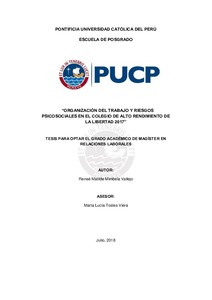| dc.contributor.advisor | Tostes Viera, Marta Lucía | |
| dc.contributor.author | Mimbela Vallejo|, Reneé Matilde | es_ES |
| dc.date.accessioned | 2019-05-18T00:08:15Z | es_ES |
| dc.date.available | 2019-05-18T00:08:15Z | es_ES |
| dc.date.created | 2018-07 | es_ES |
| dc.date.issued | 2019-05-17 | es_ES |
| dc.identifier.uri | http://hdl.handle.net/20.500.12404/14221 | |
| dc.description.abstract | El presente estudio analiza la relación existente entre la organización del trabajo en el
Colegio de Alto Rendimiento de La Libertad y la aparición de riesgos psicosociales para el
período 2017. Para llegar a identificar la relación entre estas dos variables se utilizó la
metodología del Cuestionario Psicosocial de Copenhague (CopSoQ) en la versión media:
CopSoQ istas 21.
El estudio es de tipo descriptivo, correlacional y transversal. Se aplicó técnicas
cuantitativas (Aplicación del Cuestionario CopSoQ istas 21 a 43 trabajadores) y cualitativas
(Entrevistas a directivos y a la responsable de la coordinación psicopedagógica).
De los resultados obtenidos se encuentra que la organización del trabajo del Colegio de
Alto Rendimiento de La Libertad para el período 2017, influyó de manera significativa en la
aparición de riesgos psicosociales, siendo las dimensiones más afectadas las exigencias
psicológicas y el conflicto trabajo familia que en la metodología Istas está determinada por la
doble presencia. A partir de estos resultados se elaboró a manera de propuesta un plan para
tratar y prevenir los riesgos psicosociales en la organización. | es_ES |
| dc.description.abstract | The current project examines the present-day relationship between work structures in La
Libertad’s High Functioning School, known as “Colegio de Alto Rendimiento de La Libertad”,
and the emergence of psychosocial risks for the 2017 term. In order to accurately identify the
relationship between these two variables, the researchers utilized the “CopSoQ istas 21”
method, a well-known psychosocial questionnaire of Copenhague. This type of study is
descriptive, correlational, and transversal. As well, to gather quantitative data, 43 employees
were asked to respond to the “CopSoQ istas 21” questionnaire. Furthermore, to gather
qualitative data, the researchers interviewed administrative personnel and students. According to
the findings, work structure in La Libertad’s High Functioning School had a great impact in the
emergence of psychosocial risks. Moreover, the findings revealed the most affected areas were
related to the challenging psychological conditions endured by the interviewees as well the
conflict that originates from having to find balance between family and work. Consequently,
the researchers propose a plan be implemented in order to prevent psychosocial risks within the
organization. | es_ES |
| dc.description.uri | Tesis | es_ES |
| dc.language.iso | spa | es_ES |
| dc.publisher | Pontificia Universidad Católica del Perú | es_ES |
| dc.rights | Atribución 2.5 Perú | * |
| dc.rights | info:eu-repo/semantics/openAccess | es_ES |
| dc.rights.uri | http://creativecommons.org/licenses/by/2.5/pe/ | * |
| dc.subject | Higiene industrial--Perú--La Libertad | es_ES |
| dc.subject | Ambiente de trabajo--Aspectos psicológicos--Perú--La Libertad | es_ES |
| dc.subject | Escuelas secundarias--Perú--La Libertad | es_ES |
| dc.title | Organización del trabajo y riesgos psicosociales en el Colegio de Alto Rendimiento de la Libertad 2017 | es_ES |
| dc.type | info:eu-repo/semantics/masterThesis | es_ES |
| thesis.degree.name | Magíster en Relaciones Laborales | es_ES |
| thesis.degree.level | Maestría | es_ES |
| thesis.degree.grantor | Pontificia Universidad Católica del Perú. Escuela de Posgrado | es_ES |
| thesis.degree.discipline | Relaciones Laborales | es_ES |
| renati.discipline | 312507 | es_ES |
| renati.level | https://purl.org/pe-repo/renati/level#maestro | es_ES |
| renati.type | http://purl.org/pe-repo/renati/type#tesis | es_ES |
| dc.publisher.country | PE | es_ES |
| dc.subject.ocde | https://purl.org/pe-repo/ocde/ford#5.02.04 | es_ES |






